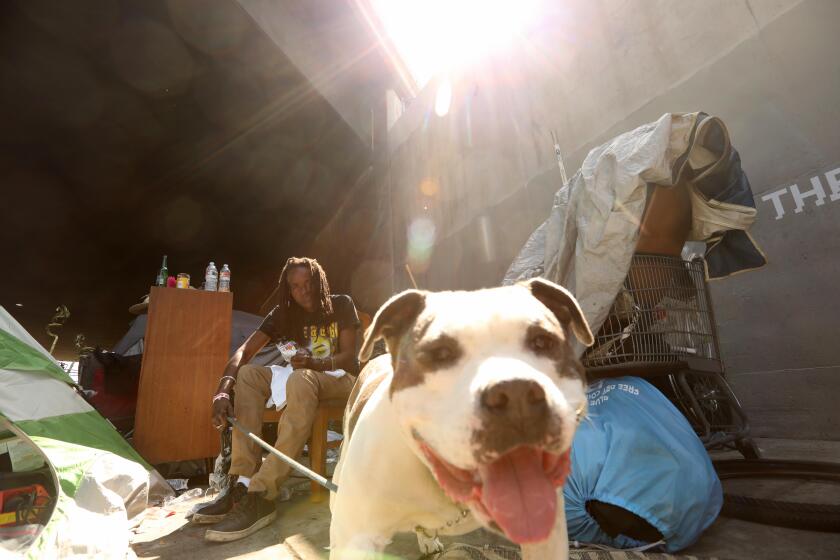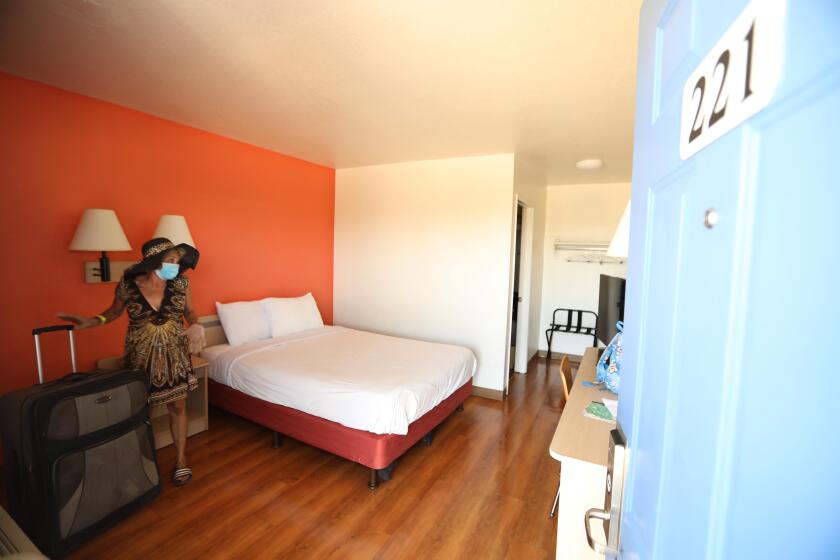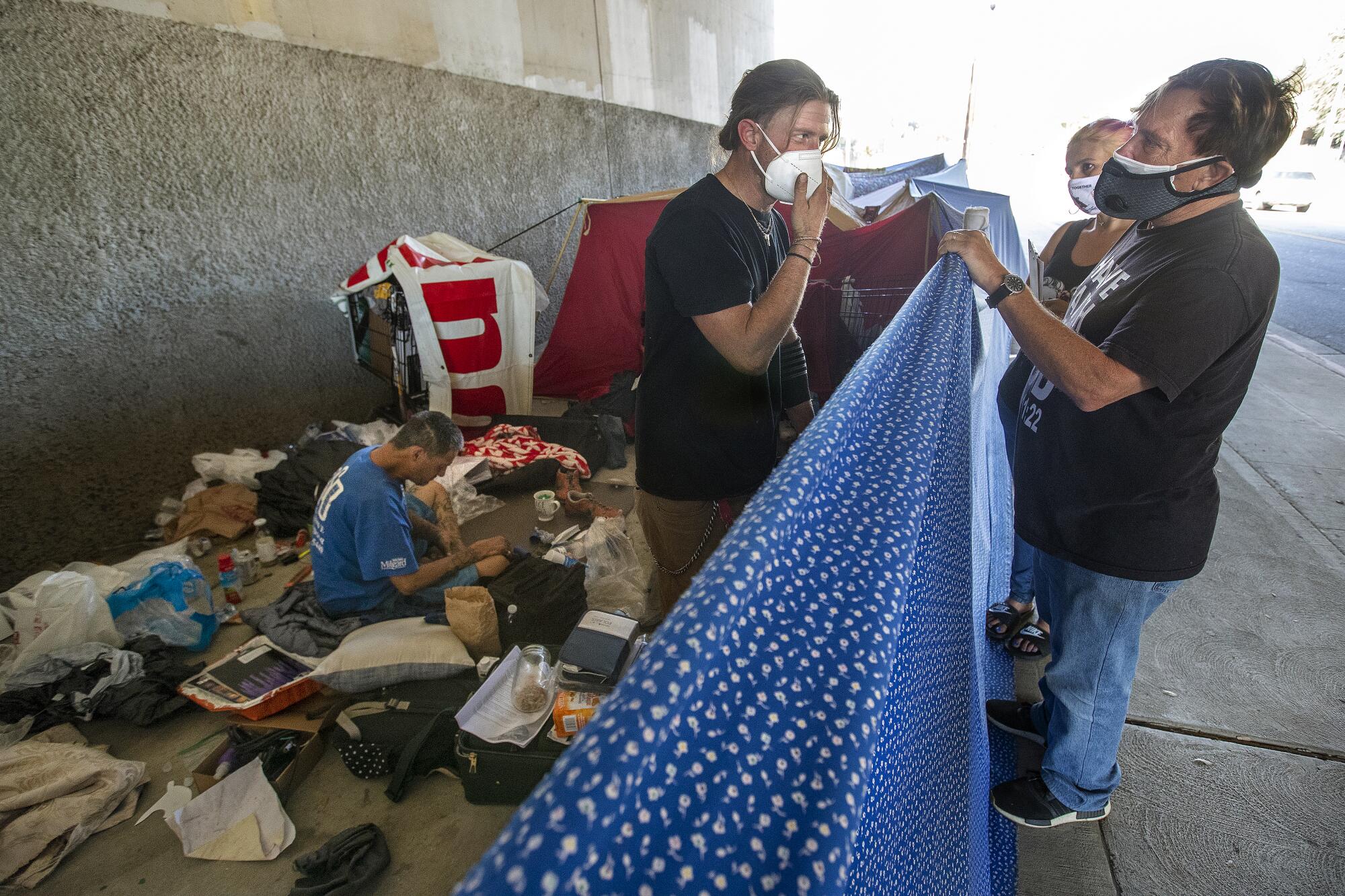
- Share via
The red Prius came to a stop under a freeway overpass in the San Fernando Valley. Out jumped Pastor Donald Dermit, bearing hygiene kits, Capri Suns and exhortations from 2 Corinthians.
Dermit and two other outreach workers approached Robin Lee and Andrew Carolus, two of the homeless people living in a cluster of tents sheltered by the 101 Freeway. Lee rolled a joint as they spoke.
Dermit offered help — and a warning: They had until Oct. 27 to clear out of the Fallbrook Avenue underpass, either to some form of shelter or to another encampment.
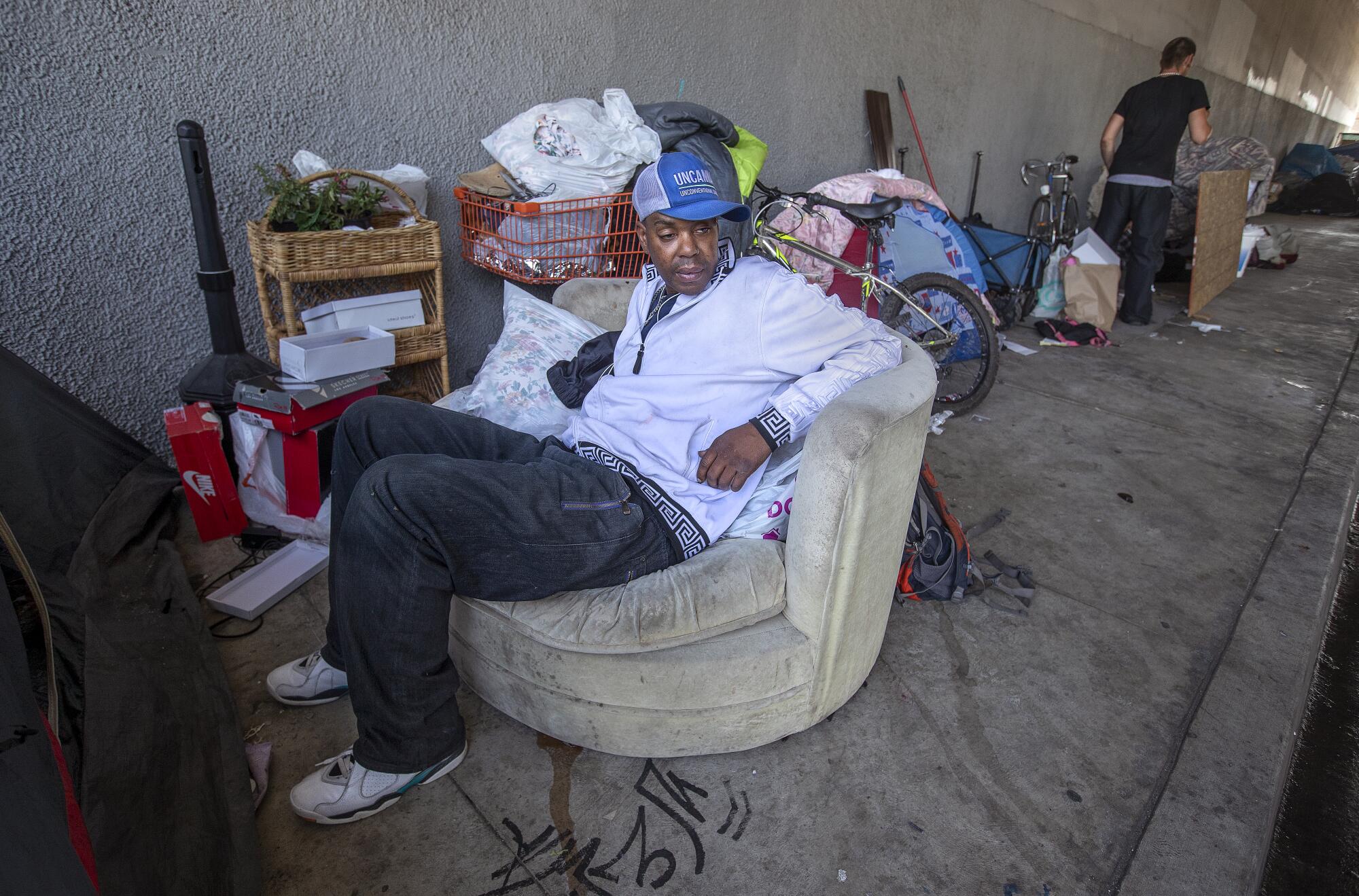
“I can be that bridge for you. Old things pass away,” Dermit told Carolus, leaning in closely with two masks shielding his mouth and nose.
Dermit helps run a homeless services nonprofit in Orange County, Helping HandUps, and has been making the long drive here at the behest of U.S. District Judge David O. Carter, who is overseeing a lawsuit filed in March by a group of downtown Los Angeles business owners and residents. They allege that the city and county of Los Angeles have failed to protect the public and provide adequate shelter for those living on the streets.
Carter has zeroed in on encampments under freeways and wants them cleared, starting with those in the West Valley district of Los Angeles City Councilman Bob Blumenfield, where Carolus and Lee were living. This month outreach workers posted notices on official city letterhead, citing the lawsuit and telling people they needed to move.
It’s unclear, however, on whose authority the moving of these people was issued.
The judge, who declined to be interviewed for this article, has put pressure on a number of people with different levels of authority including City Council members, city workers and shelter providers to focus on people near freeways instead of on the broader population of all those who are most vulnerable.
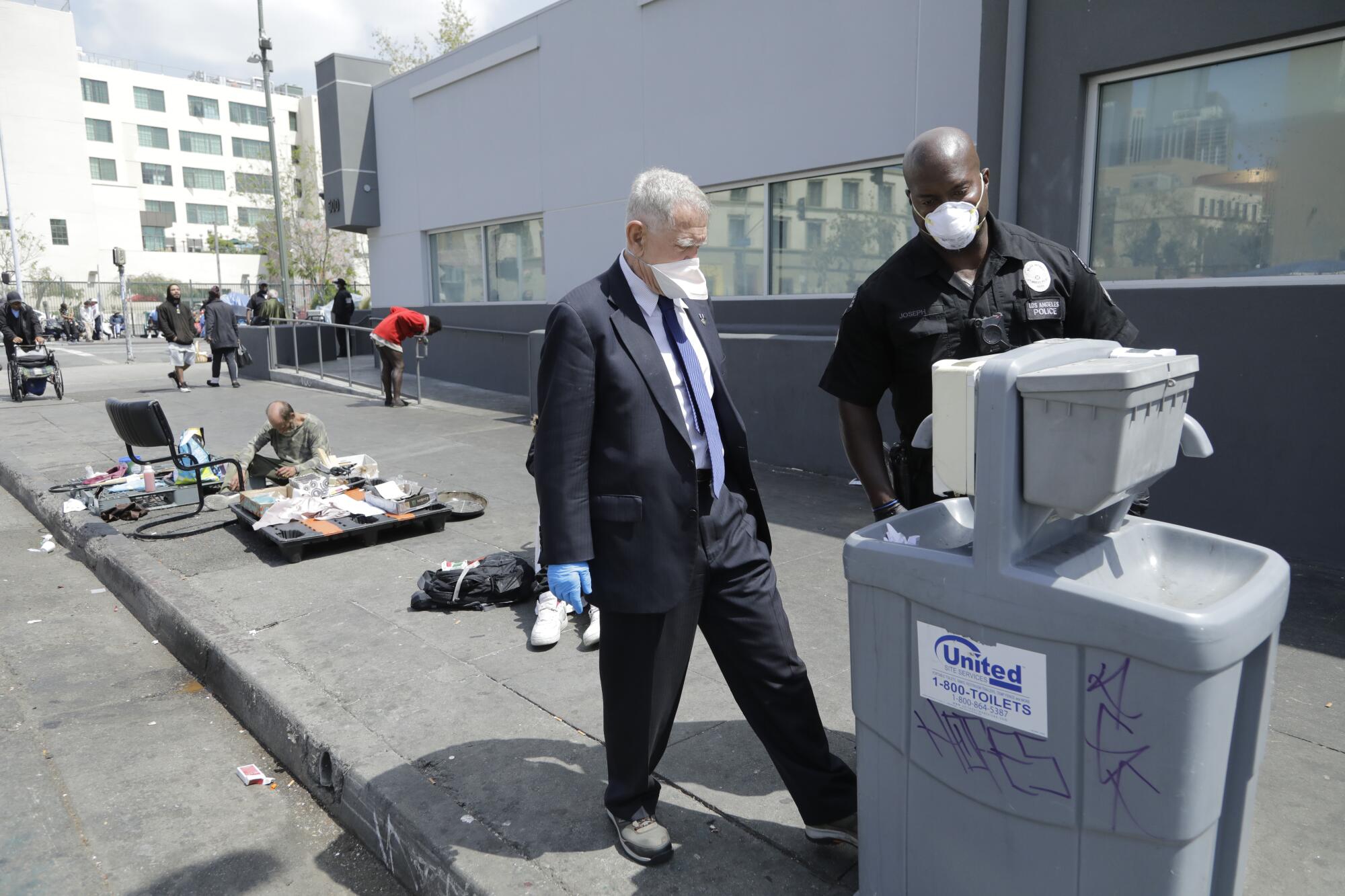
Yet Carter vacated an order he issued earlier this year demanding the clearance of the freeway-adjacent camps. And some homeless advocates, outreach workers and lawyers involved in the case say they are confused about how they are supposed to proceed, because — in their view — there may be homeless people more desperately in need of help than those camping under freeways.
“Chaos is being created by multiple voices weighing in on the best strategy,” said Stephanie Klasky-Gamer, president and chief executive of LA Family Housing, a nonprofit that coordinates the homeless services in this part of the city and has taken on the responsibility of executing Carter’s plan in the West Valley.
A judge ordered officials to provide space in shelters or alternative housing for homeless residents living near freeways. But where will they go?
“The lawsuit isn’t against LA Family Housing, and we don’t have a contract with the city to help them meet the expectations of the lawsuit. We didn’t get any additional funding to do this pilot. We’re just stepping in and doing what we typically do. ... It’s unclear who we’re taking direction from.”
The freeway camps, which have spread through the city in recent years, have brought new visibility to a problem once largely confined to skid row and a few other locations such as Venice Beach. Carter believes that their proximity to cars and their emissions poses a health threat, especially during the COVID-19 pandemic.
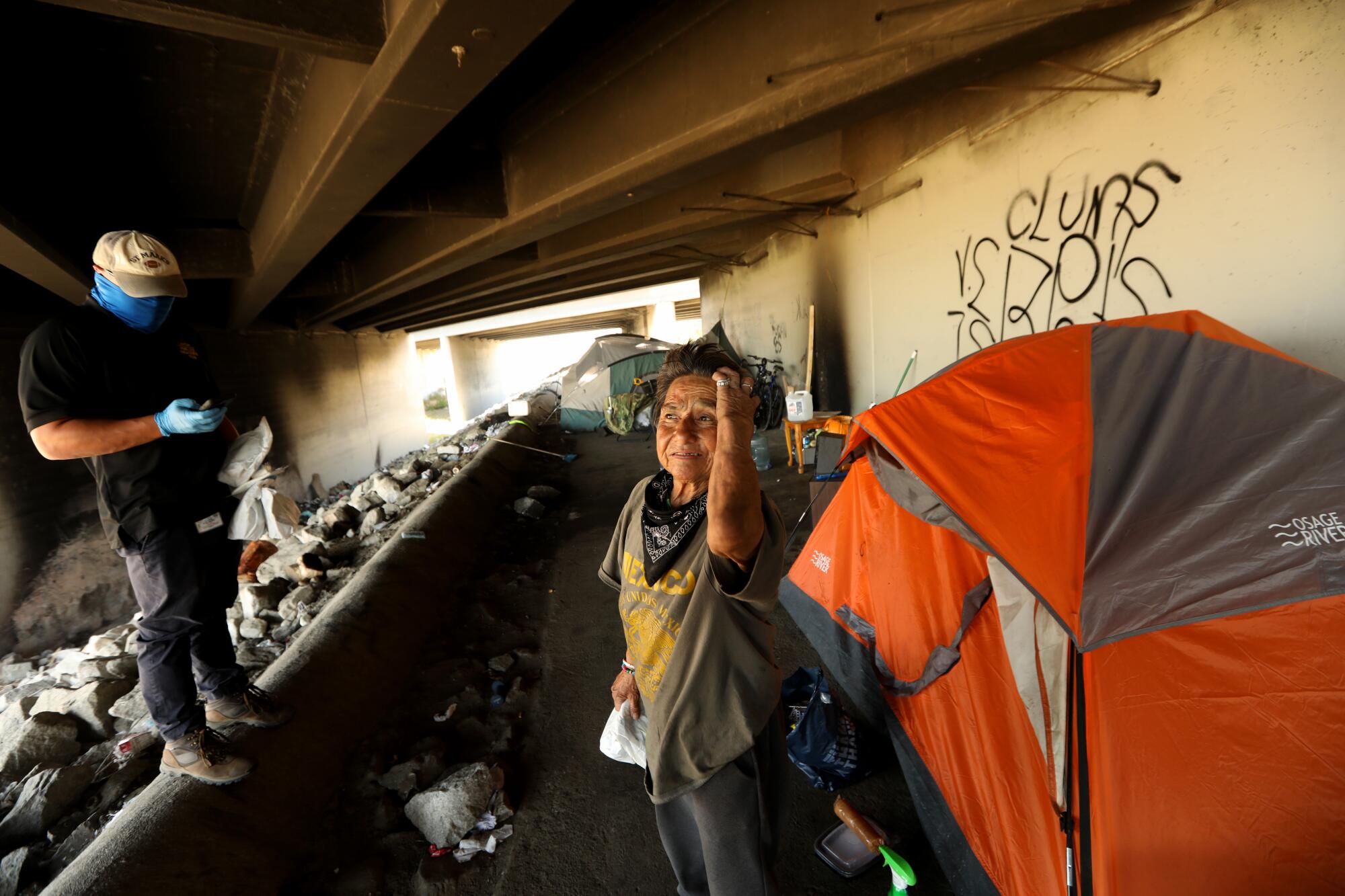
In the spring, Carter issued an order calling for the relocation of up to 7,000 people living near overpasses, offramps and on-ramps. But the order was vacated after the city and county came to an understanding about how to fund alternative shelter for people near freeways.
The agreement sets out criteria for how to pay for new forms of shelter. It says nothing about where people are not permitted to sleep. Nevertheless, the judge has continued to focus the city’s attention on the underpass camps as if the order was in force.
The plaintiffs in the lawsuit support the relocations, and argue that “Carter has been absolutely clear that there is a health and safety issue, and clearance is mandatory, regardless of vacating the order.” Similarly, in court documents, city attorneys have said Los Angeles will “enforce its laws, including its anti-camping laws, within 500 feet of such overpasses, underpasses and ramps” if people refuse to move.
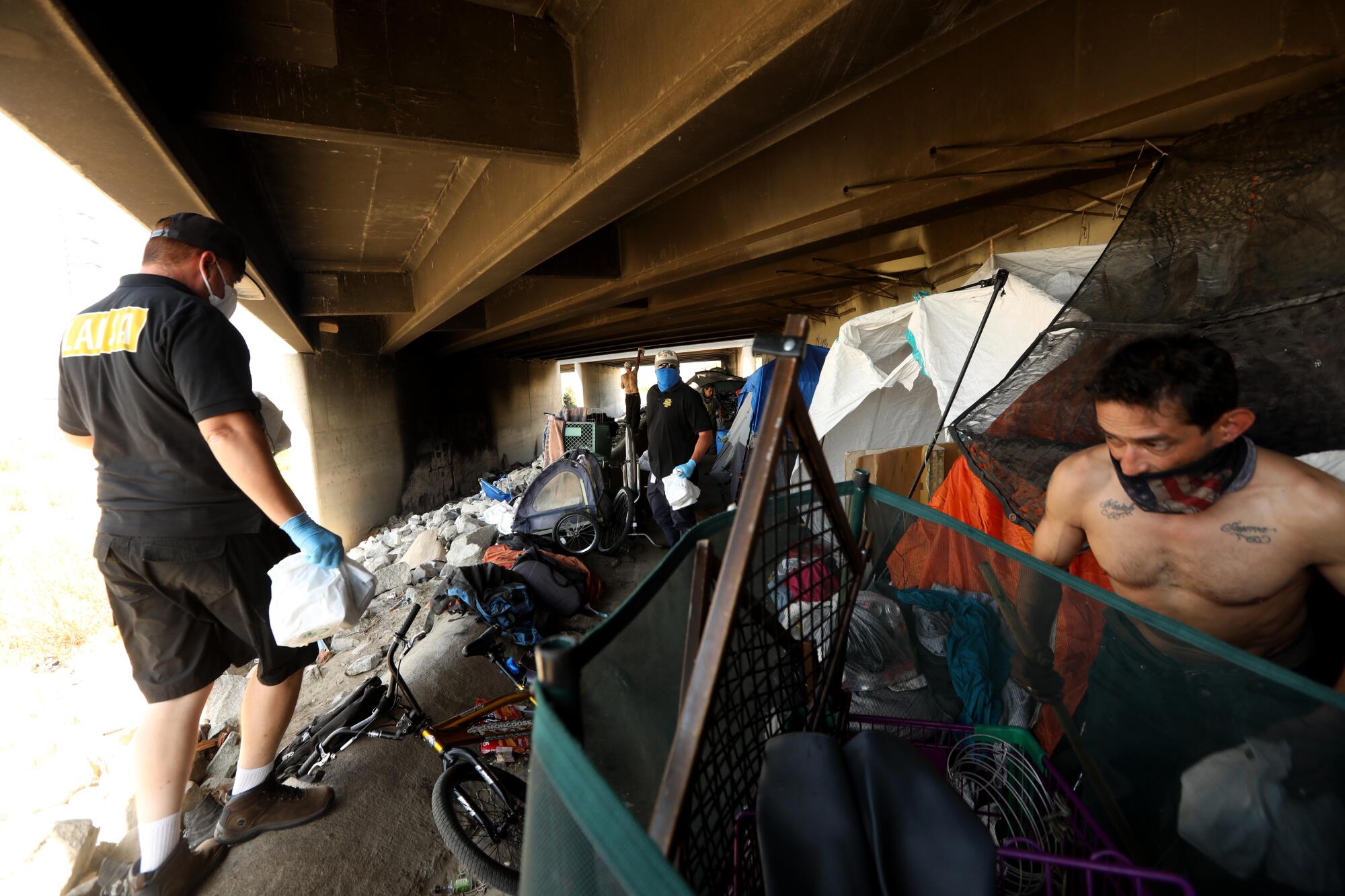
However, Legal Aid Foundation attorney Shayla Myers, who represents intervenors in the case, said last week that she believed the city had overstepped its authority by telling people they must move from beneath freeways. She said that Carter “appears to be providing instructions, which could be construed as orders,” but the relocations aren’t “being taken pursuant to any court order or court proceeding.”
Homeless services providers are trying to figure out what to do about Carter’s focus on freeways while they struggle with the tall order of finding shelter for 4,000 homeless people who are temporarily being housed in hotels but must leave soon. Along with recreation centers used as shelters, these hotels were the city’s primary pandemic response to homelessness, especially as the opening of permanent supportive housing funded by a city bond measure was delayed. (There is some discussion of keeping them open for homeless people, but that’s up in the air.)
After reaching less than 30% of its goal to shelter homeless people who are vulnerable to the coronavirus, Project Roomkey is starting to phase out in the face of funding uncertainty.
Earlier this month, Klasky-Gamer’s team found about 90 available shelter beds and 136 permanent housing units — a far cry from what is needed.
At the same time, a wave of evictions from rental housing is expected as COVID-19 continues to crush the economy. A flood of money is being spent to construct cabins in parks and convert some hotels into permanent shelters.

Those projects won’t come to fruition until the beginning of next year at the earliest. In the meantime, Klasky-Gamer and others are trying to make sure that anyone inside now doesn’t end up back on the street. It’s a daunting challenge.
Klasky-Gamer joined Carter and others on a tour of freeway encampments recently. In the spring, as the virus spread and officials feared that it would kill many homeless people, LA Family Housing was able to move almost an entire camp of about 40 people living beneath an underpass of the 118 Freeway in Pacoima into a hotel under the auspices of Project Roomkey, the state-funded program that allowed localities to lease hotel space for homeless people during the pandemic.
“There are a lot of voices at play right now with a lot of different ideas of how things should be done.”
— Heidi Marston, LAHSA executive director
“That was phenomenal,” she said. However, the city has already begun pulling out of Project Roomkey and it’s hard to rent units from private landlords en masse.
Carter is “just doing one person, one encampment at a time in one geographic area and not looking at the regional challenge in front of us,” Klasky-Game said.
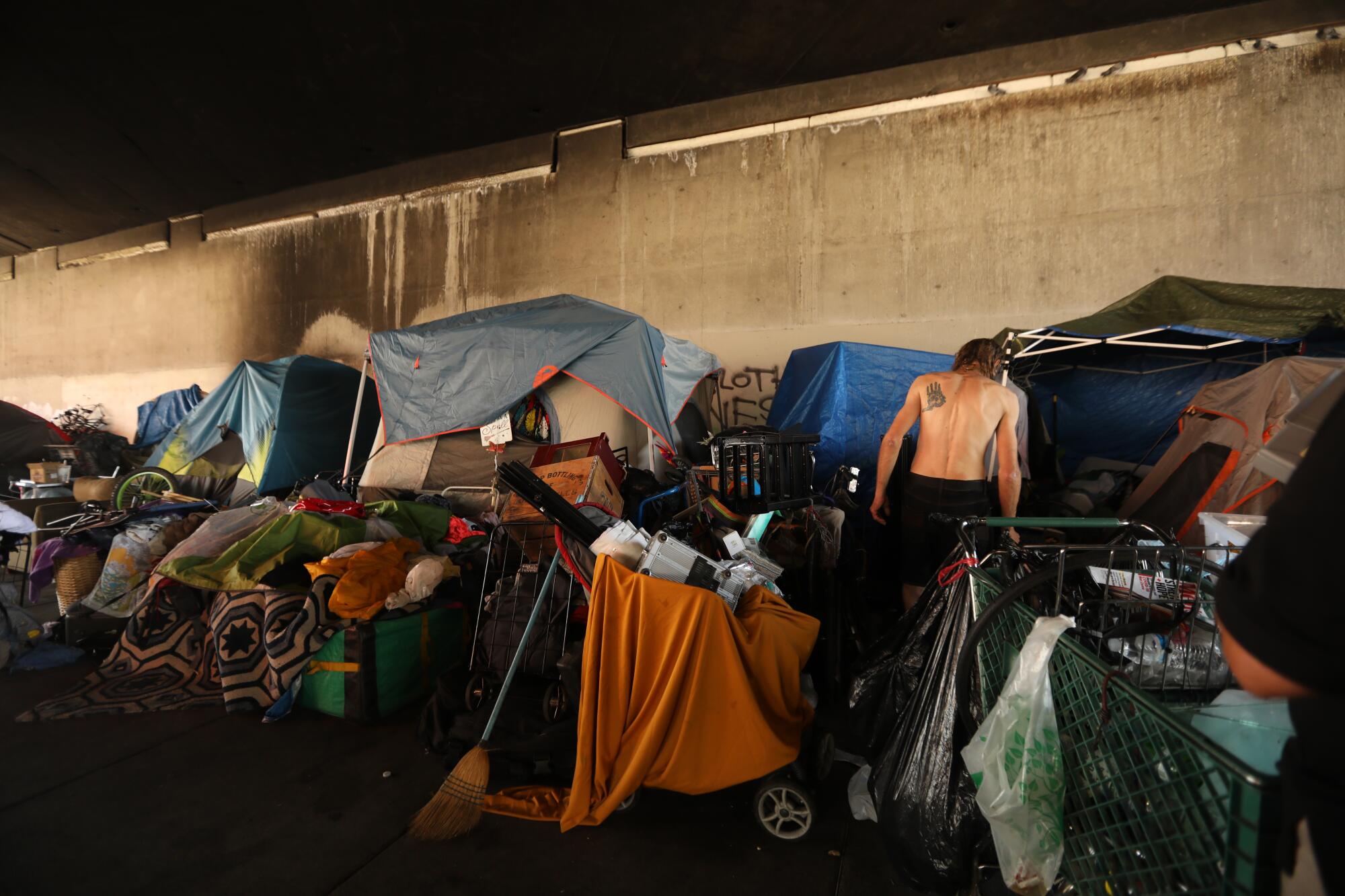
She said that once the hotels are converted into some form of permanent housing and the cabins go up, there will be more supply available. There are three temporary cabin construction projects in the works in parks in the Valley and one in South L.A. Each project would include 50 to 70 units along with toilets and showers in parks and other unoccupied plots of land.
Normally, the Los Angeles Homeless Services Authority would work with service providers such as LA Family Housing to identify the people who are most in need and do outreach to bring them indoors.
The authority is still doing that, but the process has been short-circuited as Carter has played a larger role. Over the summer, Carter had each member of the City Council identify encampments near freeways and how they would shelter those people.
These plans will then be filtered down to providers who are already stretched thin trying to respond to the pandemic.
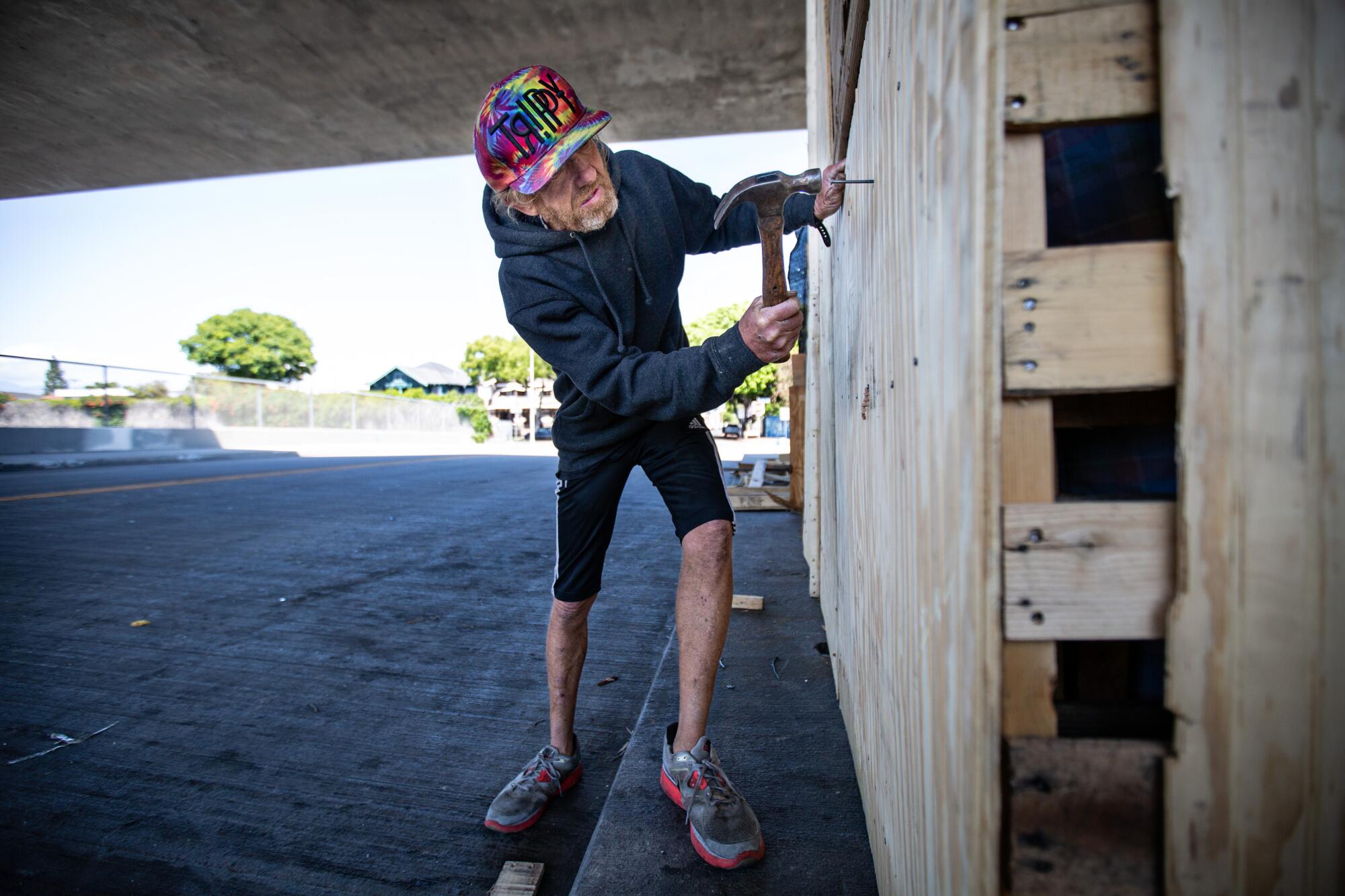
“There are a lot of voices at play right now with a lot of different ideas of how things should be done,” said the authority’s executive director, Heidi Marston. “I don’t think it’s wrong to say that there’s not one unified voice or approach.”
For elected officials like Blumenfield, Carter’s attention and efforts help accomplish two goals: getting people without a home the help they need and placating residents who are frustrated by the encampments. He supports a council motion that would ban sitting and sleeping around freeway underpasses.
Blumenfield knows by name many of the people who live beneath underpasses. His district has one of the smallest homeless populations in the city, which doesn’t stop his other constituents from complaining about them.
“[Carter] has made it clear that those freeway areas have to be cleared, which I’m thrilled about, by the way, because it’ll show the community that we’re doing something and it actually creates visible progress,” Blumenfield said.
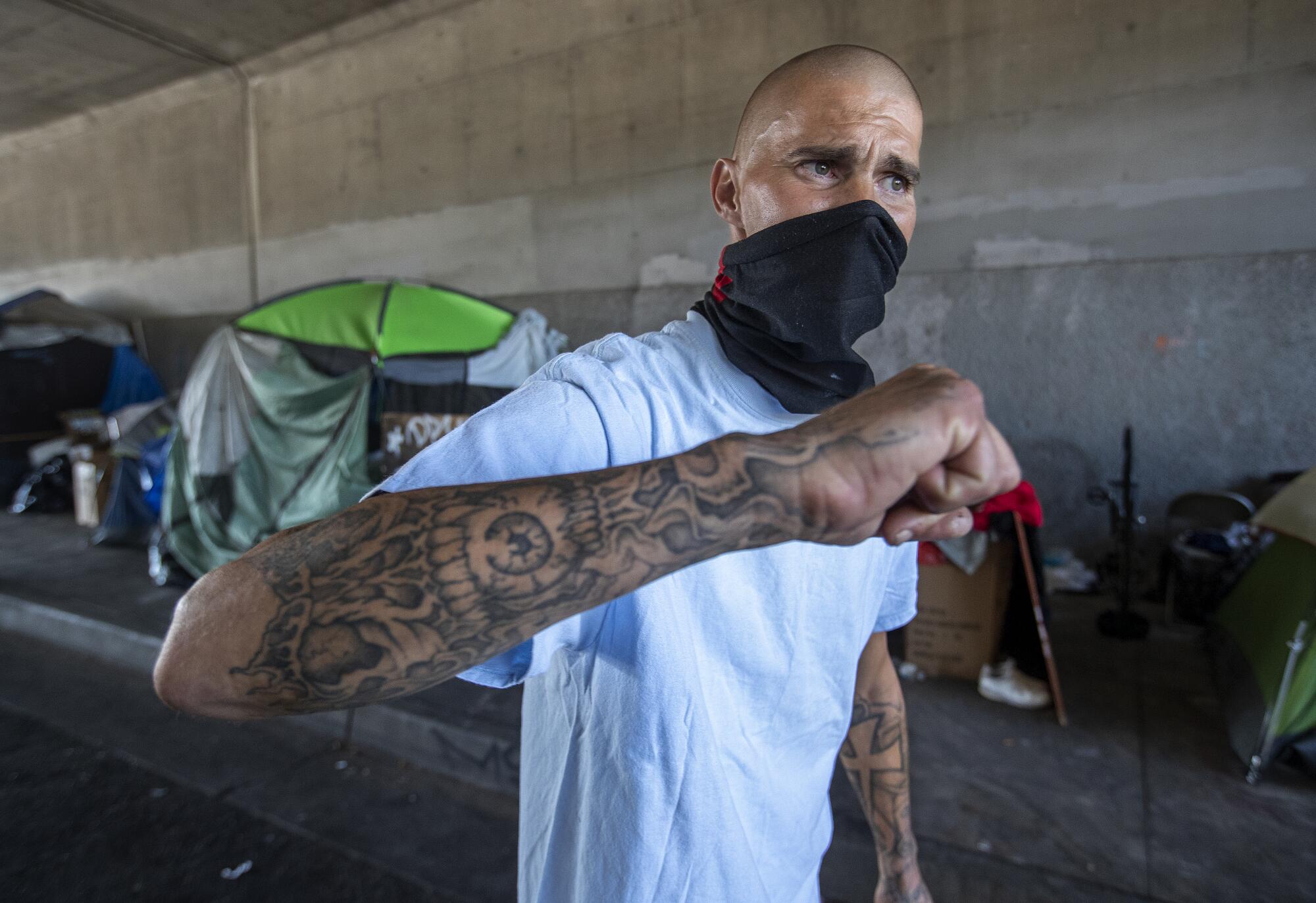
Lance Matson is not homeless but hangs with friends who live in these encampments and said Blumenfeld is a regular presence at the Corbin Avenue underpass of the 101.
He said encampments at other underpasses had been consolidated here after homeless people were hassled by local residents. As he stood talking, a silver Range Rover drove by and its driver blared its horn and yelled an obscenity out the window.
“People are so fed up. I understand,” he said. “The councilman is doing everything he can.”
Back at the Fallbrook Avenue underpass, Dermit talked with Carolus, the man who had been homeless for five years, about how he’d previously expressed some desire to go into a hotel room or shelter.
The timing just wasn’t right, Carolus said. He wanted to reconnect with his young daughter and begin to sort through his personal belongings before making another transition. Dermit listened intently, offering support and a promise that he wouldn’t abandon him during this transition.
Still, on Oct. 27, things would have to change, he said.
“We’re here to help you get into shelter,” he said. “On that date, though, you’re going to have to move from here. They’re not going to let you keep the tent here.”
More to Read
Sign up for Essential California
The most important California stories and recommendations in your inbox every morning.
You may occasionally receive promotional content from the Los Angeles Times.
